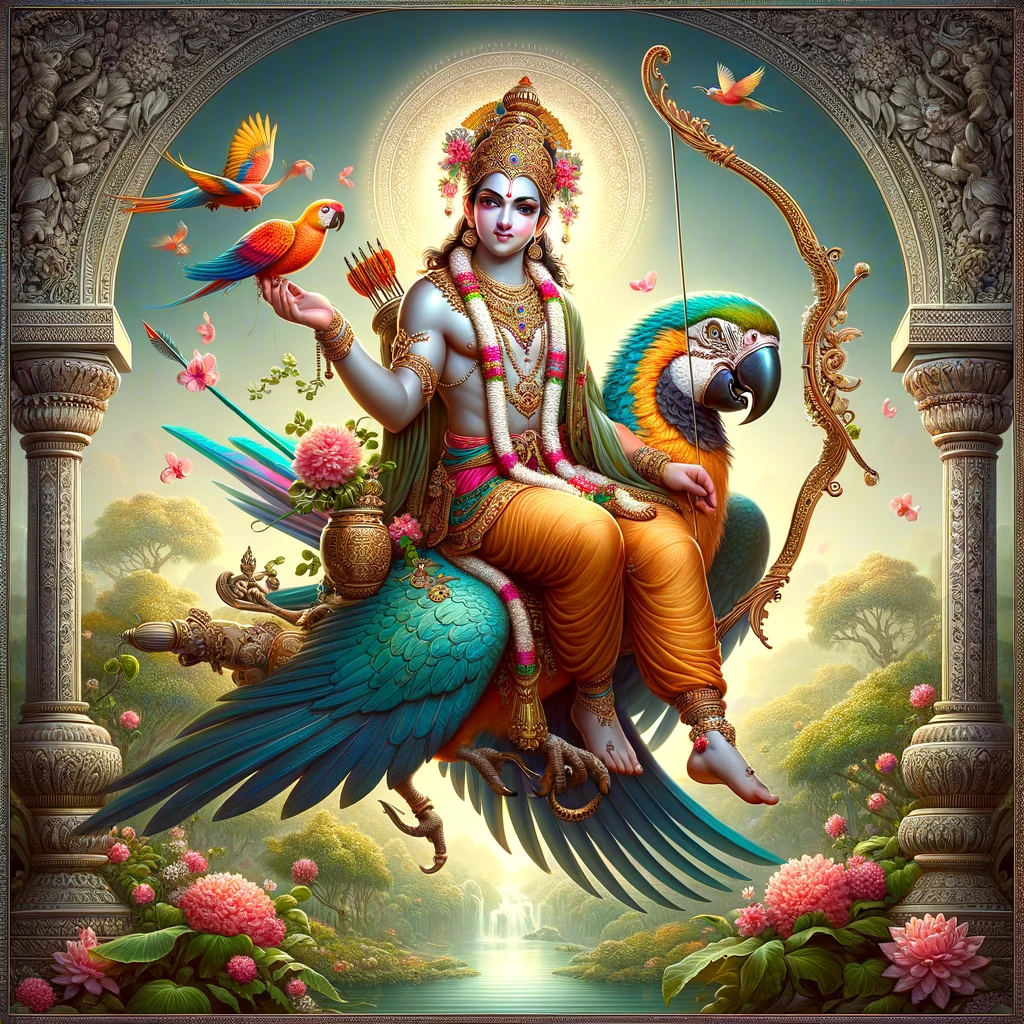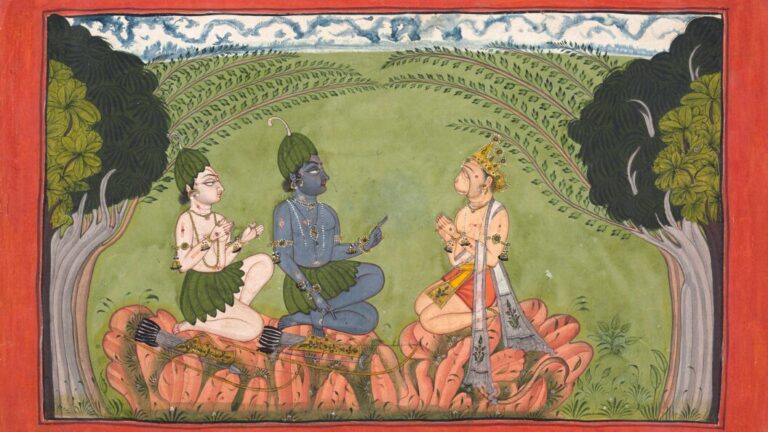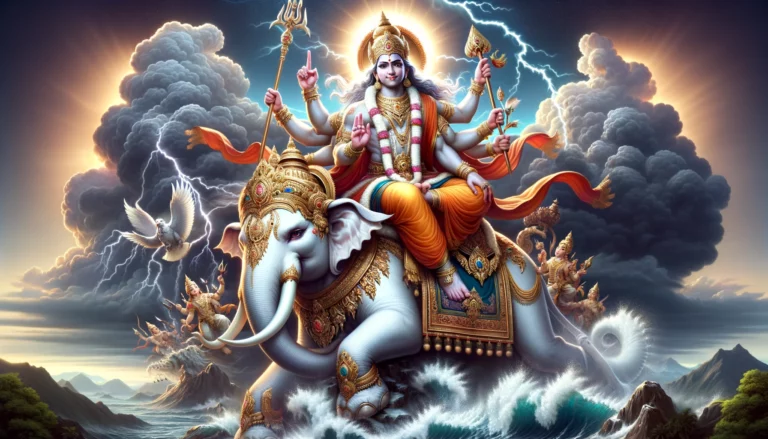Did you know the Hindu pantheon has its very own cupid?
Yep, that’s right!
Kamadeva, often hailed as the “God of Love Hindu” culture celebrates, isn’t just about shooting arrows and making people fall head over heels. His role is much more profound and nuanced in Hindu mythology.
So, who is Kamadeva, you ask?

Imagine a deity so charming, with a sugarcane bow and floral arrows, tasked with the job of spreading love and desire. Unlike the mischievous cherub you might be picturing, Kamadeva is a sophisticated symbol of passion and affection, deeply woven into the fabric of Hindu traditions.
Why is he important?
Well, in a world where love binds us all, Kamadeva’s tales offer a glimpse into the ancient understanding of desire and devotion. His stories are not just about the thrills of love but also about its power to drive spiritual growth and transformation.
And here’s a fun fact to kick things off: Kamadeva is one of the few deities who managed to disturb the meditation of Shiva, one of the supreme beings in Hinduism.
How’s that for influence?
In this light-hearted chat, we’ll dive deep into the essence of Kamadeva, exploring his mythology, significance, and the lessons he imparts on love, longing, and the pursuit of happiness.
So, buckle up, and let’s get to know the divine cupid of Hindu mythology!
Mythological Tales of Kamadeva
Got your attention? Good, because the stories of Kamadeva are as enchanting as they are insightful.
Let’s start with the most famous one, where Kamadeva takes on a mission IMPOSSIBLE.
Ever tried to distract someone who’s deep in meditation?
Kamadeva did.
And not just anyone, but Lord Shiva himself. Talk about being bold!
When the world needed Shiva’s attention, Kamadeva shot his love-laden arrow towards him.
The outcome?
A bit explosive, with Shiva opening his third eye and reducing Kamadeva to ashes.
But hey, no hard feelings, because Kamadeva’s act was all about restoring balance and, eventually, he was brought back, thanks to the plea of his consort, Rati.
But Kamadeva isn’t just about stirring trouble.
His tales are rich with themes of love, sacrifice, and the complexity of human emotions. With his consort Rati by his side, Kamadeva’s adventures offer a divine perspective on the joys and sorrows of love.
Why does this matter? Because these stories aren’t just ancient myths. They’re reflections on love’s power to transform us, to challenge us, and to push us towards our true potential.
And here’s a quirky fact: Kamadeva’s bow made of sugarcane and arrows of flowers symbolize the sweetness and beauty of love.
So next time you see sugarcane or flowers, remember, they’re not just for show or taste; they carry the essence of divine love!
In essence, Kamadeva’s stories teach us that love is both powerful and gentle, capable of causing upheaval but also healing wounds.
So, let’s take a leaf out of Kamadeva’s book and remember the strength that lies in love and compassion.
Kamadeva’s Iconography and Symbolism
Diving into the world of Hindu deities, each symbol and attribute carries profound meanings.
Kamadeva is no exception.
His iconography is not just about aesthetic appeal but deep, symbolic gestures towards the nature of love and desire.
First off, let’s talk appearance: Kamadeva is often depicted as a youthful and handsome figure, radiating charm and allure. But it’s his bow and arrows that steal the show.
Made of sugarcane and adorned with flowers, these aren’t your ordinary weapons.
They’re metaphors, people!
The sugarcane bow symbolizes the mind, and the floral arrows? The five senses.
Together, they represent the power of love to captivate the entire being.
And here’s a “did you know” moment for you:
Kamadeva’s vehicle is a parrot. Yes, a parrot! This choice of companion is no random decision. Parrots are known for their ability to mimic sounds, highlighting the communicative aspect of love and the importance of expressing one’s feelings.
Now, onto the symbolism: Kamadeva’s very essence teaches us about the beauty and necessity of emotional and physical love. His presence in mythology is a reminder that love is an integral part of life, driving creation, harmony, and spiritual growth.
- Sweetness and beauty: The sugarcane bow and floral arrows also suggest that love is both sweet and beautiful, capable of conquering all senses.
- Springtime: Often associated with Vasant Panchami, a festival marking the arrival of spring, Kamadeva’s lore is tied to renewal and rejuvenation. Spring, with its burst of life and color, mirrors the invigorating force of love in the world and in our hearts.
So, what’s the takeaway?
Kamadeva’s iconography is a rich tapestry, weaving together themes of allure, communication, and the sensory experience of love.
It teaches us to embrace love’s transformative power, to express our feelings boldly and beautifully, much like the parrot, and to remember that at the heart of all creation is the sweet, compelling pull of love.
Remember, the next time you spot a sugarcane or admire the beauty of flowers, there’s a deeper connection to the divine narrative of love and desire, as symbolized by Kamadeva, the God of Love in Hindu mythology.
Worship and Festivals Dedicated to Kamadeva
In the colorful tapestry of Hindu festivals, Kamadeva has a special place, symbolizing the celebration of love and the arrival of spring.
But how is the God of Love Hindu culture reveres, celebrated and worshipped?
Let’s dive into the festivities and rituals that honor Kamadeva, bringing communities together in a joyous appreciation of love’s power.
Kamadeva’s main festival is Holi, the vibrant festival of colors that marks the end of winter and the abundance of spring.
While Holi is celebrated for many reasons, one of its aspects is honoring Kamadeva and his sacrifice.
Remember the story where he was turned to ashes by Shiva?
Well, Holi commemorates Kamadeva’s brave act of love and his resurrection, showcasing the enduring power of love even in the face of destruction.
Rituals: On Holi, people invoke Kamadeva through songs, dances, and the playful throwing of colors. It’s believed that these celebrations please Kamadeva, promoting harmony and affection among those participating.
Madanotsava is another festival linked directly to Kamadeva, celebrated during the spring season. This festival is all about embracing the joy and sensuality of love, with ancient texts describing elaborate rituals and festivities dedicated to Kamadeva and Rati.
So, what’s unique about these celebrations?
- They blend spiritual significance with earthly enjoyment, reflecting Hinduism’s holistic view of life.
- They encourage the expression of love and affection, not just towards partners, but within families, friendships, and communities.
- They remind us of love’s power to renew and regenerate, mirroring nature’s cycle of rebirth in spring.
And a fun fact for you: During these festivals, it’s common for devotees to offer flowers, incense, and sweets to images or icons of Kamadeva and Rati, seeking blessings for love and happiness in their lives. It’s a beautiful blend of devotion and celebration, highlighting the importance of love in human life.
To wrap it up, the worship and festivals dedicated to Kamadeva are a testament to the enduring legacy of love in Hindu culture. They teach us that love, in all its forms, is worth celebrating, worth sacrificing for, and definitely worth dancing about.
So next time you’re caught up in the revelry of Holi, spare a thought for Kamadeva, the divine cupid, whose legends infuse the festival with its spirit of joy, color, and love.
Kamadeva in Literature and Art
Kamadeva, the God of Love in Hindu mythology, isn’t just confined to temples or religious texts. He’s a celebrity in his own right, making grand appearances in literature and art throughout the ages.
His charm isn’t just about looks; it’s literary and artistic too!
In ancient scriptures, Kamadeva’s tales are lavishly detailed, providing not just entertainment but moral lessons.
The Rig Veda, one of the oldest texts in the world, mentions him, highlighting his significance from the earliest times. Then there’s the Puranas, where his stories with Shiva and his wife Rati unfold, giving us deeper insights into the complexities of love and desire.
But Kamadeva’s influence doesn’t stop there.
He’s a muse for poets and artists, inspiring countless works that explore the nuances of love.
From classical Sanskrit literature like the Kumarasambhava by Kalidasa, which narrates the burning of Kamadeva by Shiva, to the vibrant paintings that adorn palace walls and temple corridors, Kamadeva’s presence is everywhere.
What makes him such a favorite?
- His universal appeal: Love is a theme that resonates across cultures and epochs, making Kamadeva a timeless icon.
- The rich symbolism: His imagery, from the sugarcane bow to the floral arrows, offers deep symbolic layers for artists and writers to explore.
- The emotional depth: Kamadeva’s stories touch on the various aspects of love, from the physical to the spiritual, providing a wellspring of inspiration for creative minds.
And here’s a quirky tidbit: In modern times, Kamadeva might not wield his bow in the digital world of emojis and GIFs, but his essence survives in every love song, romantic novel, and the endless streams of Valentine’s Day cards. He’s the ancient god who’s never gone out of style.
In conclusion, Kamadeva’s legacy in literature and art is a testament to his enduring appeal. His narratives and symbols enrich the cultural tapestry, offering insights into the human heart and the power of love.
So next time you come across a poetic verse or a piece of art that stirs the heart, remember, you might just be feeling the touch of Kamadeva’s floral arrow.
The Spiritual Aspect of Love According to Hinduism
When we talk about Kamadeva, the God of Love in Hindu culture, it’s easy to get caught up in the tales of his adventures and misadventures.
But there’s a deeper layer to this: the spiritual dimension of love that Kamadeva embodies. This isn’t just about earthly desires; it’s about elevating those feelings to a divine level.
In Hindu philosophy, love transcends the physical and enters the realm of the spiritual. It’s considered a path to self-realization and understanding the divine. Kamadeva’s stories, while rich in earthly passions, also hint at this higher purpose of love.
- Love as a divine force: In Hinduism, love is seen as a powerful force that can lead to enlightenment and unity with the divine. It’s about dissolving the ego and realizing the interconnectedness of all beings.
- Kamadeva’s role: While he may be the deity of physical desire, his purpose is also to remind us of the joy and beauty of love in all its forms. Through love, individuals can transcend their limitations and connect with something greater than themselves.
And here’s something to ponder: Isn’t it fascinating how the ancient texts weave together love’s sensual and spiritual aspects? They don’t shy away from desire but instead celebrate it as a natural, divine force that can lead to spiritual awakening.
So, what can we learn from Kamadeva?
- Love, in its essence, is divine. It’s a force that enriches our lives, encouraging growth, empathy, and connection.
- The pursuit of love, both physical and spiritual, is a journey towards understanding the deeper truths of existence.
- Celebrating love, in all its forms, is a way to honor the divine within and around us.
To wrap it up, Kamadeva’s depiction as the God of Love in Hindu mythology offers more than just stories of desire and passion. It provides a profound commentary on love’s role in the spiritual journey of life. Love, according to Hinduism, is a sacred path to discovering the divine essence that dwells within each of us.
Remember, the next time you experience love, think of it as a divine gift, a spiritual practice that has the power to transform and elevate. Kamadeva’s tales are not just ancient myths but timeless lessons on the beauty and sanctity of love.
Conclusion
As we wrap up our journey through the vibrant tales and deep symbolism of Kamadeva, the God of Love in Hindu culture, it’s clear that his stories are more than mere myths.
They are rich narratives that weave together the physical, emotional, and spiritual dimensions of love, offering insights that transcend time and culture.
Kamadeva’s legacy is a reminder that love, in all its forms, is a powerful and divine force that shapes our lives, our relationships, and our spiritual journeys.
Whether it’s the playful colors of Holi, the intricate tales of the Puranas, or the profound lessons of the Vedas, Kamadeva’s presence is felt across the vast expanse of Hindu tradition and beyond.
What have we learned?
- That love, with all its complexities, is an essential part of human experience and spiritual growth.
- Kamadeva’s stories and symbols teach us about the beauty of desire, the importance of expression, and the transformative power of love.
- The celebration of Kamadeva in festivals, literature, and art highlights the universal appeal of love and its capacity to unite us.
Remember that love is not just a fleeting emotion but a divine spark that connects us to each other and the universe.
Frequently Asked Questions
Who is Kamadeva in Hindu mythology?
Kamadeva is the Hindu god of love and desire, often depicted with a bow made of sugarcane and arrows of flowers. He plays a significant role in various Hindu myths, including the story of his temporary destruction by Lord Shiva.
What are the symbols associated with Kamadeva?
The symbols associated with Kamadeva include a bow made of sugarcane and arrows adorned with flowers, representing the sweetness and beauty of love. He is also often depicted riding a parrot, symbolizing communication and the power of words in love.
How is Kamadeva celebrated or worshipped in Hindu culture?
Kamadeva is celebrated during the festival of Holi, where his stories are remembered and rituals invoking his blessings for love and companionship are performed. He symbolizes the joy and color of love, aligning with the festival’s theme of renewal and joy.
What lessons can we learn from Kamadeva’s stories?
Kamadeva’s stories teach us about the power of love to conquer all obstacles, the importance of balance between spiritual and earthly desires, and the transformative power of love in personal and spiritual growth.


